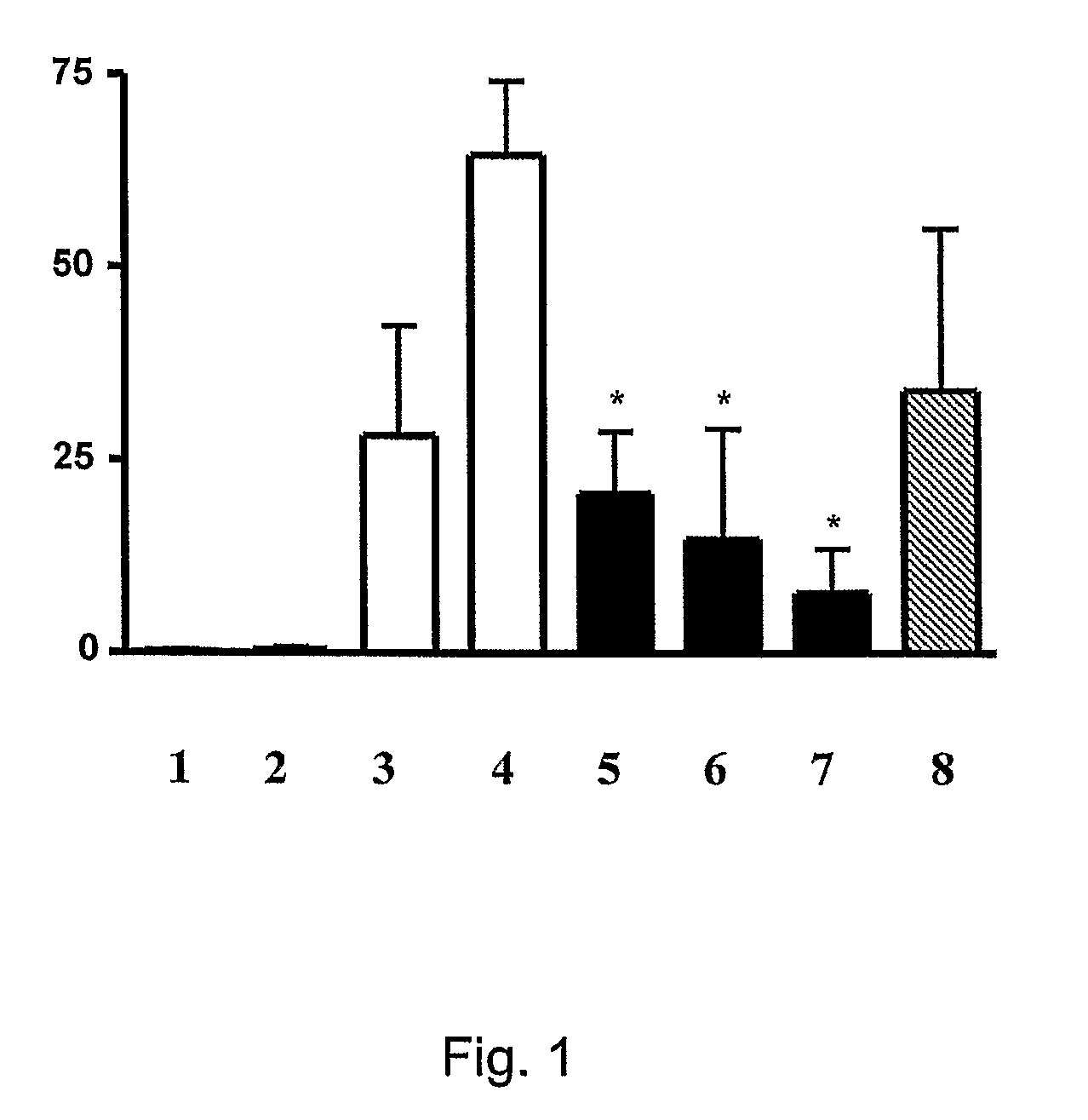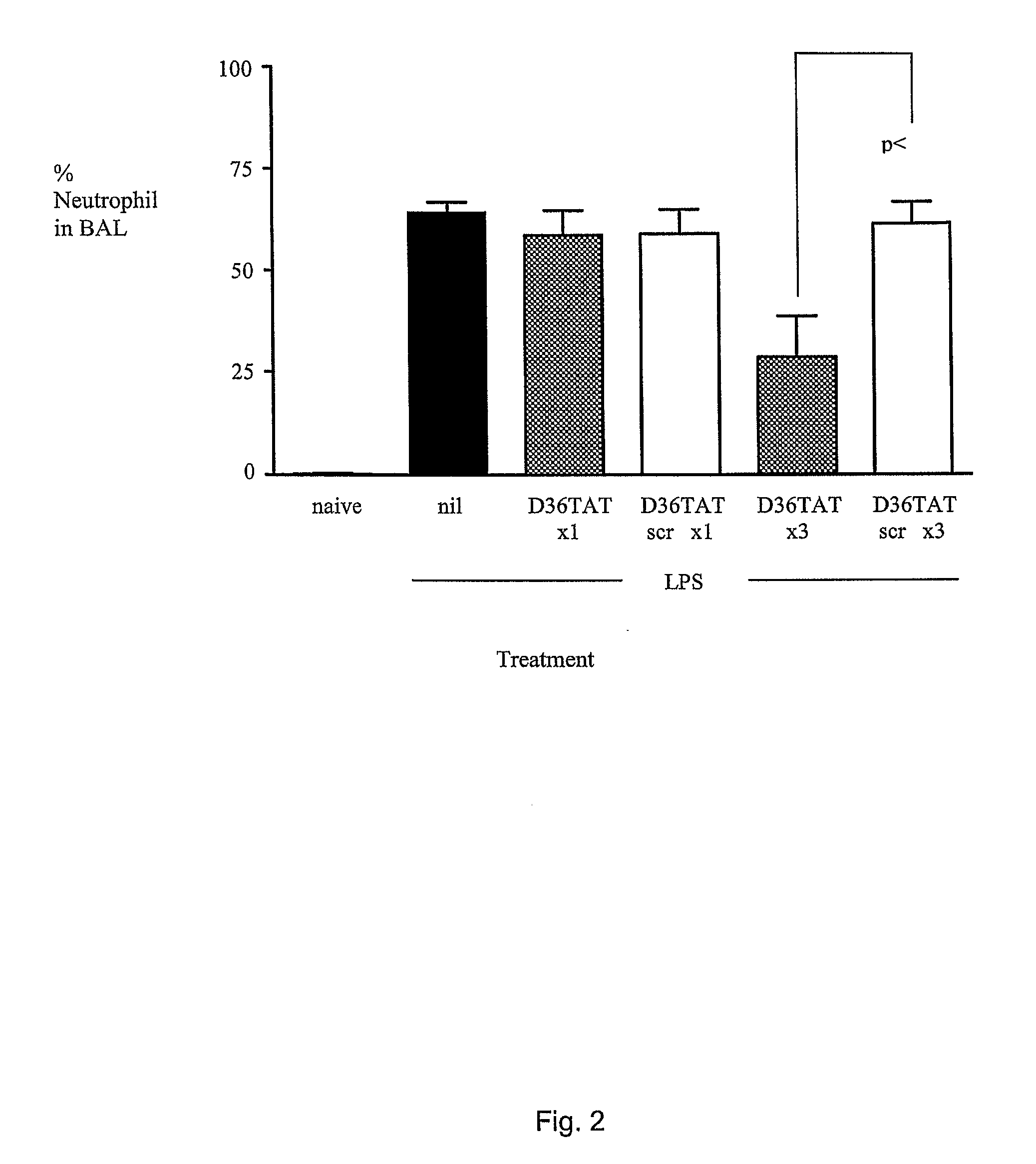Compositions and uses thereof for the treatment of acute respiratory distress syndrome (ARDS) and clinical disorders associated with therewith
a technology of acute respiratory distress syndrome and formulation, applied in the field of intranasal formulation, can solve the problems of asymptomatic abnormalities, lung edema, right ventricular failure, etc., and achieve the effects of reducing neutrophilic-inflammation, reducing turnover, and reducing surfactant production
- Summary
- Abstract
- Description
- Claims
- Application Information
AI Technical Summary
Benefits of technology
Problems solved by technology
Method used
Image
Examples
example 1
Isolation of an Inhibitor of AP-1 Signaling
[0317]Nucleic acid was isolated from the following bacterial species:
1Archaeoglobus fulgidis2Aquifex aeliticus3Aeropyrum pernix4Bacillus subtilis5Bordetella pertussis TOX66Borrelia burgdorferi7Chlamydia trachomatis8Escherichia coli Kl29Haemophilus influenzae (rd)10Helicobacter pylori11Methanobacterium thermoautotrophicum12Methanococcus jannaschii13Mycoplasma pneumoniae14Neisseria meningitidis15Pseudomonas aeruginosa16Pyrococcus horikoshii17S nechosistis PCC 680318Thermoplasma volcanium19Thermotoga maritima
[0318]Nucleic acid fragments were generated from the genomic DNA of each genome using 2 consecutive rounds of primer extension amplification using tagged random oligonucleotides with the sequence: PCR amplification was performed using the Klenow fragment of E. coli DNA polymerase I in the following primer extension reaction:
ReagentVolumeDNA (100-200 ng)4μlOligonucleotide comprisingSEQ ID NO: 33 (25 μM)H2Oto 17.4μl.
[0319]Samples were then b...
example 2
Inhibition of Neutrophil Infiltration by Inhalation of Peptidyl Inhibitors of AP-1 Signaling in an Animal Model of ARDS and Sepsis
1.1 Materials and Methods
Animals
[0351]8-12 week old C57 / B16 mice were purchased from the Animal Resource Center, Murdoch University, Western Australia and used for all experiments. All experiments were approved by the necessary institutional animal ethics committees and were performed in accordance with the National Health and Medical Research Council (NHMRC) Australian Code of Practice for the Care and Use of Animals for Scientific Purposes.
Peptides
[0352]Peptides used were synthesised by Mimotopes Pty Ltd (Melbourne, Australia) and supplied as a lyophilised powder (purity >90%).
[0353]Peptides comprising the sequences set forth in SEQ ID NOs: 104 and 106 and 108 are D-form retro-inverted mimetics of peptides originally identified in a screen for inhibitors of AP-1 signaling e.g., by virtue of inhibiting c-Jun dimerization (as described in Example 1, i.e.,...
example 3
Inhibition of Neutrophil Infiltration by Injection of Peptidyl Inhibitors of AP-1 Signaling in an Animal Model of ARDS and Sepsis
1.1 Materials and Methods
20 Animals
[0355]8-10 week old female C57 / B16 mice were purchased from the Animal Resource Centre, Murdoch University, Western Australia and used for all experiments. Mice were maintained free of pathogens at the Telethon Institute for Child Health Research (TICHR). All animal care handling techniques and experimental methods were approved by the TICHR Animal Experimentation Ethics Committee, which operates under the strict guidelines set out by the National Health and Medical Research Council (NHMRC).
Peptides
[0356]Peptides used were synthesised by Mimotopes Pty Ltd (Melbourne, Australia) and supplied as a lyophilised powder (purity >90%).
[0357]Peptides comprising the sequence set forth in SEQ ID NO: 106 is a D-form retro-inverted mimetic of a peptide originally identified in a screen for inhibitors of AP-1 signaling e.g., by virtue...
PUM
| Property | Measurement | Unit |
|---|---|---|
| Hydrolysable | aaaaa | aaaaa |
| Disorder | aaaaa | aaaaa |
Abstract
Description
Claims
Application Information
 Login to View More
Login to View More - R&D
- Intellectual Property
- Life Sciences
- Materials
- Tech Scout
- Unparalleled Data Quality
- Higher Quality Content
- 60% Fewer Hallucinations
Browse by: Latest US Patents, China's latest patents, Technical Efficacy Thesaurus, Application Domain, Technology Topic, Popular Technical Reports.
© 2025 PatSnap. All rights reserved.Legal|Privacy policy|Modern Slavery Act Transparency Statement|Sitemap|About US| Contact US: help@patsnap.com



